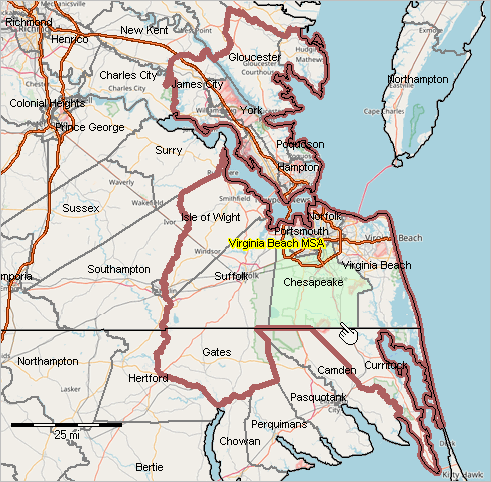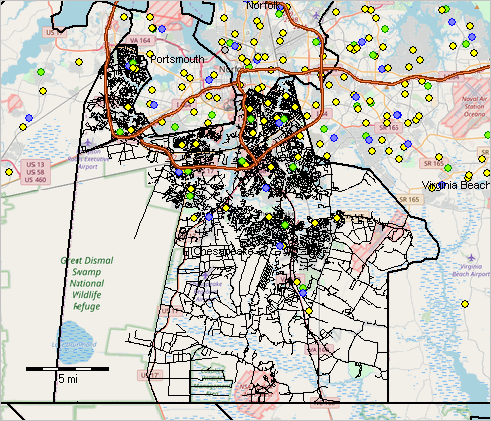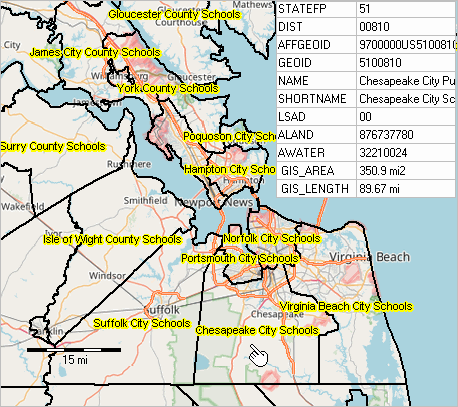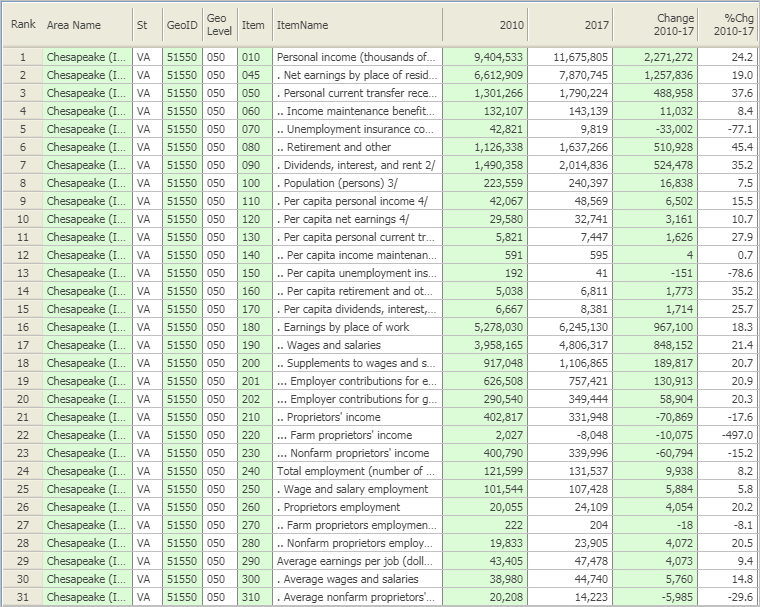

|
|
Chesapeake City & Public Schools Virginia -- Geographic, Demographic & Economic Characteristics & Trends
February 2019. Chesapeake City and school district Virginia is a coterminous area that is part of the Virginia Beach-Norfolk-Newport News, VA-NC MSA (47260). See Situation & Outlook Virginia Beach metro report for information on the metro geographic, demographic and economic characteristics and trends. The total population of the metro changed from 1,679,945 in 2010 to 1,725,246 in 2017, a change of 45,301 (2.7%). Among all metros, this metro ranked 37th in 2017, based on total population. It ranked 66th based on population change from 2010 to 2017 and ranked 359th based on population percent change from 2010 to 2017. This document is an illustrative report focused on the geographic, demographic and economic characteristics and trends for Chesapeake City & Public Schools Virginia developed by ProximityOne. It provides insights into the current situation, trends and outlook for the school district community. These data and information can help stakeholders, policy-makers and leadership better understand the current situation and how it might change. A similar report can be prepared for any county/school district. See terms of use. Chesapeake City in Context of the Metro Chesapeake City is shown with a green highlight in the following view. In the State of Virginia, there are many independent cities, such as Chesapeake City, that are treated as county equivalents for many geographic and statistical data development purposes.  - view developed with CV XE GIS software .. click graphic for larger view. Chesapeake City Lay of the Land and Demographics Chesapeake city is shown with a green highlight in the following view.  - view developed with CV XE GIS software .. click graphic for larger view. The demographics of Chesapeake city (2017 population estimate 240,397) as a county equivalent may be compared to peer group counties based on population size using this interactive table (scroll down to the green and white table). There are six counties that have a 2017 population estimate between 235,000 and 245,000: Chesapeake city, St. Johns County, FL, Lafayette Parish, LA, Hinds County, MS, Clay County, MO, and Norfolk city, VA. The demographic characteristics and trends of Chesapeake city as a county equivalent may be viewed in this profile. As described in there, these data are based on the most recent estimates developed by the Census Bureau. The demographics of Chesapeake city may be examined/compared to peer group cities based on population size using this interactive table (scroll down to the green and white table). The demographic-economic attributes Chesapeake city may be examined/compared to peer group school districts based on population size using this interactive table based on American Community Survey 2017 5-year (ACS1317) estimates that include all cities. As the Chesapeake school district is over 65,000 population, use the corresponding this interactive table based on American Community Survey 2017 1-year (ACS2017) estimates to examine 2017 characteristics and in context of other school districts over 65,000 (approximately 1,000 school districts). Examine annual estimates of total population, children ages 5-17 and children in poverty for Chesapeake city, and all school districts, using this interactive table. These data have been developed to meet the needs of the Department of Education as one factor to use in the allocation of Title I funds. Extended data on the K-12 infrastructure, schools, enrollment by type and grade, teachers and related data are integrated into the GIS project and datasets used to develop this document. Users of that resources can interactively view/examine characteristics at the school level in context with other geographies. Patterns of Economic Prosperity by Census Tract The following view shows patterns of economic prosperity based on ACS 2017 estimates of median household income by census tract. See color pattern and income intervals in legend at left of map. K-12 public schools are shown by circular markers by school level as shown in the legend at left of map.  - view developed with CV XE GIS software .. click graphic for larger view. There are 41 Census 2010 census tracts that comprise Chesapeake city that range in median household income from $28,582 to $125,938. Rank, compare attributes of these census tracts on many demographic-economic measures using the four ranking tables shown at http://proximityone.com/tracts17dp3.htm. Use the table to view only tracts in Chesapeake City by using the Chesapeake City county equivalent code 51550 (state-county FIPS code) in the query tool below the table. Chesapeake City Area Urban and Water Area The following graphic shows the urban area by census block with salmon fill pattern. Blocks with no land area are shown with blue fill pattern.  - view developed with CV XE GIS software .. click graphic for larger view. Chesapeake City Roads, Census Blocks & Attendance Zones ProximityOne develops a demographic composite scaled index, based on selected, weighted factors at the block group and census block level for school districts. The index is assigned to intersection to intersection street segments and can be used to examine patterns at the street face/census block level to develop school attendance zones.  - view developed with CV XE GIS software .. click graphic for larger view. Virginia Beach Metro by School District  - view developed with CV XE GIS software .. click graphic for larger view. Chesapeake City Economy Characteristics of the Chesapeake economy are shown in the table presented below. These data are part of the Regional Economic Information System (REIS). Use this interactive table to view/examine the Chesapeake city economy in context of the metro and/or other areas.  Terms of Use .. goto top Data provided via this section are intended for personal, non-business use only. The data may not be used in business, consulting or for-fee applications. Any use of these resources is solely at the discretion of the user. There is no warranty or guarantee of any type. ProximityOne User Group Join the ProximityOne User Group to keep up-to-date with new developments relating to metros and component geography decision-making information resources. Receive updates and access to tools and resources available only to members. Use this form to join the User Group. Support Using these Resources Learn more about accessing and using demographic-economic data and related analytical tools. Join us in a Data Analytics Lab session. There is no fee for these one-hour Web sessions. Each informal session is focused on a specific topic. The open structure also provides for Q&A and discussion of application issues of interest to participants. Additional Information ProximityOne develops geodemographic-economic data and analytical tools and helps organizations knit together and use diverse data in a decision-making and analytical framework. We develop custom demographic/economic estimates and projections, develop geographic and geocoded address files, and assist with impact and geospatial analyses. Wide-ranging organizations use our tools (software, data, methodologies) to analyze their own data integrated with other data. Follow ProximityOne on Twitter at www.twitter.com/proximityone. Contact us (888-364-7656) with questions about data covered in this section or to discuss custom estimates, projections or analyses for your areas of interest. |
|
|